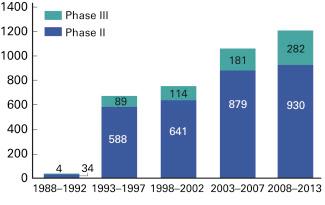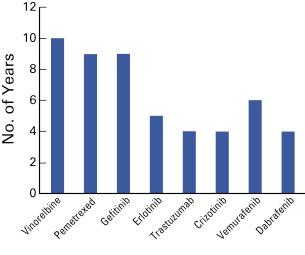Physical Address
304 North Cardinal St.
Dorchester Center, MA 02124
Despite two decades of progress, the prognosis for patients with lung cancer remains poor. Therefore forming new hypotheses and conducting clinical trials to investigate this patient population are still important.
Accordingly, in the past 25 years, the number of clinical trials involving patients with lung cancer has increased dramatically ( Fig. 60.1 ); however, only a minority of these trials have been conducted on an academic basis. In addition, only a few of these trials have led to a real change in practice. For example, fewer than 10 new drugs were approved for the management of cancer during 2013, with only one drug having a new indication and two drugs having an expanded indication for patients with lung cancer.

While international societies, including the International Association for the Study of Lung Cancer, have encouraged patient participation in clinical trials, the number of patients actually included in such trials worldwide is very low. The actual proportion of patients with cancer who participate in oncology clinical trials is difficult to determine, usually ranging from 2% to 7% in Western countries. However, if we compare the 7.5 million people who die of lung cancer worldwide per year with the reported accrual in clinical trials, the actual proportion of patients with lung cancer who are included in clinical trials worldwide is probably closer to 0.1% to 1%.
Therefore the improvement and promotion of clinical research related to lung cancer are of crucial importance. This chapter provides some proposals that are intended to enable researchers to better organize and promote clinical trials that are designed to advance research and science toward reducing the burden of thoracic malignancies worldwide.
Does lung cancer still exist as an entity? The answer is that it probably does not, considering the progress that had been made in developing a better clinical, pathologic, and biologic definition of this disease. Consequently, including all of these patients in a single trial is irrelevant. However, most clinical studies focus on obtaining a reliable estimate of the average treatment effect in a broad population of patients. In practice, clinical trials in oncology involve a delicate balance between the need for reliable evidence for a large population and the need to integrate biomarkers and thus to focus on the population carrying these biomarkers against which the targeted therapies are supposed to be efficient. For example, many drug developments have been stopped because of the absence of focus on predefined biomarkers. The first clinical trials analyzing the effect of epidermal growth factor receptor (EGFR)-tyrosine kinase inhibitors such as gefitinib independently of EGFR status or cetuximab with an inappropriate biomarker threshold led to disappointing results, despite the high number of patients enrolled. Conversely, the selection of patients on the basis of the accurate biomarker (EGFR-activating mutation, anaplastic lymphoma kinase [ALK] translocation) recently led to impressive results with fewer patients. Therefore lung cancer is now considered to comprise a mosaic of rare diseases, and clinical trials should be designed adequately.
Patients are obviously waiting for rapid improvement in the treatment of the disease, and the delay between the discovery of a new biologic target, preclinical proof of principle, and the approval of a new drug (or a new strategy) is generally viewed as unacceptably long. From this perspective, at least, the expectations of drug companies are consistent with those of patients. Is this situation changing? Perhaps, indeed, the delays between the results of the first phase I study and the European Medicines Agency (EMA) and/or the US Food and Drug Administration (US FDA) approval of new biomarker-guided drugs appear shorter when compared with those for previous standard chemotherapy ( Fig. 60.2 ). In addition, the results presented during the 2013 American Society of Clinical Oncology (ASCO) meeting by Canadian colleagues suggest that biomarker-guided treatments clearly have the greatest chance of demonstrating an activity after starting clinical development than do standard, nonbiomarker-guided, treatments. Indeed, after the assessment of more than 2400 trials, the authors found that the likelihood of a new drug passing all phases of clinical testing and being approved (i.e., the cumulative clinical trial success rate) was 11%, which was less than the expected industry aggregate rate (16.5%). The success of phase III trials was found to be the biggest obstacle for drug approval, with a success rate of only 28%. Biomarker-guided targeted therapies (with a success rate of 62%) and receptor-targeted therapies (with a success rate of 31%) were found to have the highest likelihood of success in clinical trials. Accordingly, Subramanian et al. conducted a survey to review ongoing clinical trials involving patients with nonsmall cell lung cancer (NSCLC) as listed in the ClinicalTrials.gov registry in 2012 and found that the number of clinical trials with biomarker-based treatment selection for lung cancer had significantly increased since 2009 (from 7.9% to 25.8%; p < 0.001).

The costs of a clinical trial depend on many factors. An audit of industry-sponsored clinical trials in oncology recently indicated that the average cost is $165 million for basic research and discovery, $87 million for preclinical development, $130 million for a phase I trial, $190 million for a phase II trial, and $268 million for a phase III trial. It seems that the use of a validated biomarker, such as human EGFR-2 for breast cancer, reduces clinical trial risk by as much as 50%, resulting in cost savings of 27% in advanced and metastatic breast cancer. This percentage is comparable with the results of a large study in which the use of biomarkers decreased the cost of drug development by 26%. It is difficult to have a worldwide picture of the funding of clinical trials in oncology. However, one recent example in the United States showed how academic-sponsored clinical trials in oncology are fragile. At the time of the federal budget cuts in 2013, a survey showed that a large proportion of US oncologists consequently reduced the end points of trials (36.9%), closed or participated in fewer cooperative group trials (28.3%), postponed the launch of clinical trials (26.7%), and limited enrollment in clinical trials (23.1%). Therefore adapting the design of oncology clinical trials and durably ensuring their funding are important.
Instead of testing therapeutic strategies or new chemotherapeutic drugs, clinical researchers now face a huge amount of basic-science data and preclinical concepts. The challenge is to build the most appropriate trials to validate some of these hypotheses. A dispensable time in the building of a clinical trial is to deeply analyze the preclinical data and to anticipate all issues that may impair the development of the drugs (efficacy, toxicity, pharmacokinetics, etc.).
Advances in biotechnology and genomics gradually have uncovered the biology of lung cancer. Deeper understanding of the biology of the disease can facilitate the development of new treatments, whereas deeper understanding of the heterogeneity of the disease can facilitate the development of effective biomarkers or diagnostic tests that can be used to select appropriate treatments for individual patients. In particular, the recent establishment of high-throughput molecular assay technologies, such as high-throughput sequencing, single-nucleotide polymorphism arrays, gene-expression microarrays, and protein arrays, has allowed for the discovery of potential new biomarkers and the development of composite genomic signatures for personalized medicine.
Consequently, different trial designs have been proposed on the basis of the incidence of a given biomarker. For example, early phase trials initially tested the efficacy of a drug in a population harboring a rare molecular abnormality such as v-raf murine sarcoma viral oncogene homolog B (BRAF) mutation or ALK translocation. Then, randomized trials were conducted in populations with a more frequent or better characterized molecular alteration. Nevertheless, those studies can be criticized, as the prognostic value of the biomarker by itself (independent of its predictive value) is often underestimated. Therefore we again need new designs of clinical trials in oncology.
Thousands of studies are carried out every year around the world, involving thousands of patients and billions of dollars of investment. In addition, conducting clinical trials, especially when the patient population is small, as is the case for the current development of the vast majority of biomarker-guided inhibitors, is necessarily competitive. First, at the time of targeted clinical trials in oncology, only centers with high-level facilities can still test and enroll patients, and, when two or more studies are in competition, substantial time and resources that otherwise could have been applied to other valuable projects inevitably will be wasted. Second, the winner is not necessarily the best treatment, as the trials are conducted sequentially. Third, there is also a competition between industrial and academic trials in that they often involve the same patients but have different trial designs. Fourth, there is competition between countries as each country has its own way of funding trials. Thus it is sometimes harder to conduct international trials because of the complexity of administrative procedures. Therefore collaborations, networks, and simplified rules are needed.
Become a Clinical Tree membership for Full access and enjoy Unlimited articles
If you are a member. Log in here